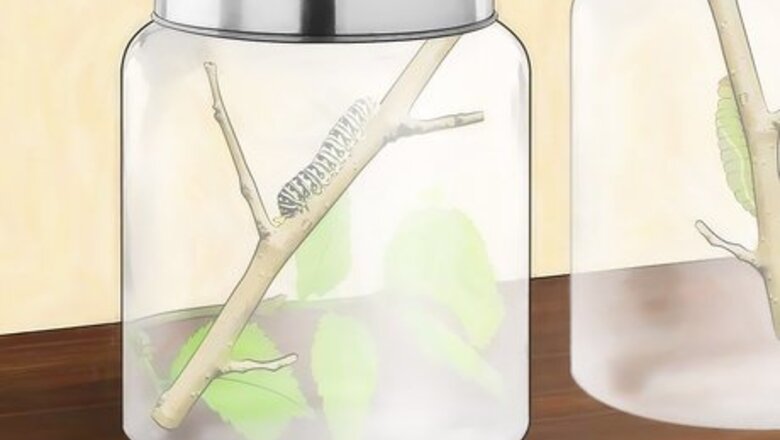
views
If you're trying to rescue a sick or injured butterfly, find the info you're looking for here.
Starting with Caterpillars

Start with baby caterpillars. If this is your first time raising caterpillars, you might want to start with a caterpillar kit. You can order a kit online and choose from a variety of butterfly species. The kit will come with everything you need to raise the caterpillars into butterflies. If you prefer, you can instead find caterpillars in your neighborhood and provide what they need to become healthy butterflies. It's a little trickier since you'll need to find fresh food for them every day, but you'll learn a lot about a species native to your area. If you want to buy a butterfly kit, consider getting a species that will be able to survive in your region after you release it. Do a little research to find out which butterfly populations in your area could use a boost. If you want to find your own caterpillars, go outside and look around. Look for the following host plants to find different caterpillar species: Caterpillar/Butterfly Species Host Plant Monarch Milkweed Spicebush Swallowtail Spicebush Zebra Swallowtail Paw-paw Black Swallowtail Dill, fennel and parsley

Keep the caterpillars in a 1 gallon (3.8 L) jar covered with cheesecloth. This will keep the caterpillars from crawling away and getting free while also giving them a safe, well-ventilated environment. You can fasten the cheesecloth over the mouth of the jar with a rubber band to keep it in place. If you ordered a butterfly kit, it would come with a jar and ventilated lid for you to use. Put no more than 2 to 3 caterpillars together in a jar. If they all become butterflies, they'll need plenty of space when they emerge from their chrysalises. The caterpillar's jar will need to be cleaned every day since caterpillars produce a lot of waste. If you just leave the waste in the jar, mold can grow, which is unhealthy for the caterpillars. Line the jar with paper towels that you can switch out for easy cleanup. Place long sticks in the jar so that the caterpillars have a place to climb. When you change out the paper towels, be very careful not to damage the caterpillars. Wait until they're climbing on the sticks, then gently lift them out as you switch out the paper. It might be helpful to have a second jar lined with paper. so you can simply switch them back and forth.
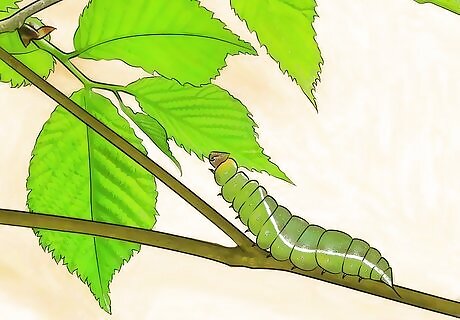
Feed the caterpillars fresh leaves every day. This won't be necessary if you're using a kit, which comes with processed caterpillar food, but caterpillars you find in the wild will need fresh leaves every day. They're picky eaters and will only consume leaves from their source plants. Remember which type of plant you found your caterpillars on and feed them fresh leaves accordingly. Caterpillars won't eat old or dried-out leaves, so it's important to make sure that what you feed them is fresh. You might want to grow the host plant in a pot, so you always have some available. Caterpillars get the water they need from leaves, so there's no need to add water to the jar. If you aren't sure what type of caterpillar you have, consult a field guide to try to find out. If you can't figure it out, you should release the caterpillar, since it will die if you try to feed it the wrong food.
Helping Baby Butterflies Fly
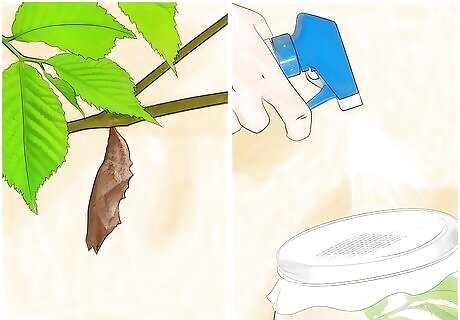
Take care of the chrysalides. A chrysalis is a caterpillar that has entered the pupae stage, the stage during which it goes through a transition and turns into a butterfly. The chrysalides will usually be attached to a stick since the butterfly needs to be able to hang when it emerges. During this stage, your job is to keep the environment in the jar nice and moist so that the chrysalis won't dry out. Use a spray bottle to spritz inside the jar from time to time. The pupae stage lasts for several months, and during this time you won't see much activity, but rest assured that the pupa is alive and will eventually emerge. If you captured the caterpillar in the fall, it should emerge in time for spring.

Make sure they're in a good spot. If the chrysalides are not attached to a stick, or not hanging in a spot where the butterflies will be able to stretch out, you'll need to move them to a better spot. If the butterflies emerge too close to the bottom of the jar, or in a cramped spot where they can't hang and stretch their wings, their wings won't properly form, and they won't be able to fly. If a chrysalis is on a stick that's too close to the bottom of the jar; you can simply move the stick, so it's positioned in a better way. You could also tape the bottom of the stick to another stick to make it longer if you need to. The chrysalis should be positioned near the top of the jar, hanging from the underside of the stick. If the chrysalis is resting on the bottom of the jar; you need to attach it to a stick. Use a dab of slightly cooled hot glue to glue one edge of the chrysalis to the underside of a stick, then position the stick in a good spot.
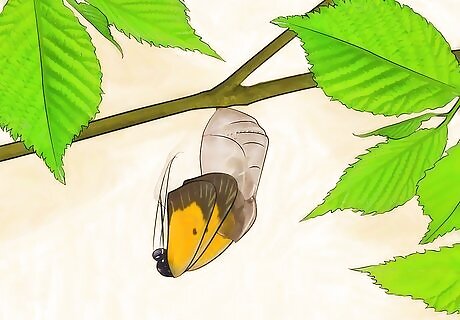
Watch for the butterflies to emerge. After several months, the chrysalides will begin to turn dark or clear, indicating it's time for the baby butterflies to come out. It only takes a few seconds for them to come out and begin stretching their wings. They'll hang from the underside of the stick and slowly move their wings, giving them time to harden. Again, if they don't have space for this essential process, their wings will never fully form, and they won't be able to fly. When it looks like the butterflies are going to emerge soon, make especially sure that the environment inside the jar is nice and humid. If a butterfly falls to the bottom of the jar, don't fret! It should be able to climb the stick and find a good spot to hang.
Releasing and Feeding Adult Butterflies
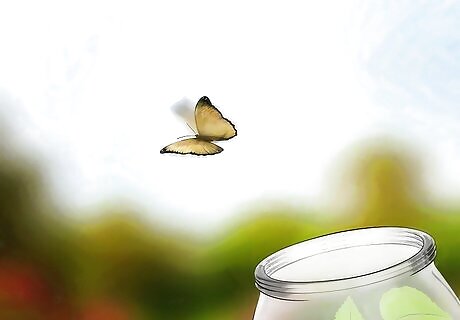
Release the butterflies when they begin to fly. When they start fluttering around the jar, it's time! Take the jar outside and place it near their host plant. Open the jar and let the butterflies go free. Enjoy the fact that you contributed to your local ecosystem by helping the butterfly population thrive. Butterflies have the best chance of survival if you set them free, rather than trying to keep them indoors. If it's cold outside or you simply want to observe them for a few days, you can keep them inside for a bit. Put them in a huge jar with several sticks, and feed them the sugar solution detailed in the next step.
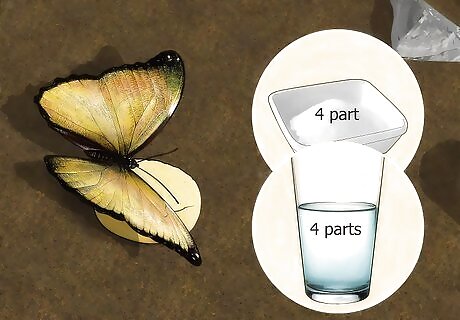
Feed butterflies a sugar solution. If you want to feed the butterflies, either because it's too cold to release them or you'd like to watch them eat, you can set out a small sponge soaked with a solution of one part sugar to four parts water. Butterflies will land in the sugar water and taste it with their feet. Don't put a dish or puddle of sugar water out, since butterflies can get covered with it and end up sticky, making it difficult or impossible for them to fly. Don't add any coloring to the sugar water.
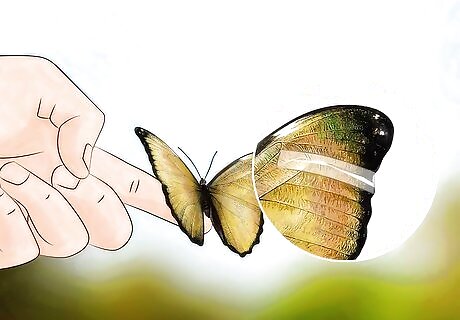
Rescue sick butterflies. If you see a butterfly that seems to be moving slowly or stumbling around or one with a torn wing, there are measures you can take to rescue it! Always remember to handle the butterfly gently if you try one of these first aid treatments: For a butterfly that seems weak or hungry, you can rescue it by helping it eat. Mix up some sugar water and set out a sponge soaked in it. Gently take the butterfly's wings between your thumb and forefinger, using utmost care not to pinch too hard. Set the butterfly on the sponge. Butterflies feed through a curved tube. If it doesn't unfurl, you can help it along by gently extending it toward the food using a toothpick. Once the butterfly feels restored, it will fly away. For a butterfly with a torn wing, you can tape the wing to help it heal. Use a very lightweight, clear tape. Gently hold the butterfly's body with one hand and use the other to place a small piece of tape on one side of the butterfly's wing. This will keep the wing held together and help the butterfly fly again.

Plant a butterfly garden for long-term butterfly care. If you want your yard to be a haven for butterflies, you can help them out by planting a garden full of butterfly host plants and other plants that attract butterflies. Consider planting the following species (and many more) to keep butterflies happy and healthy in your area: Milkweed Dill Fennel Parsley Bee balm Mint Lavender Lilac Privet Sage Zinnia




















Comments
0 comment